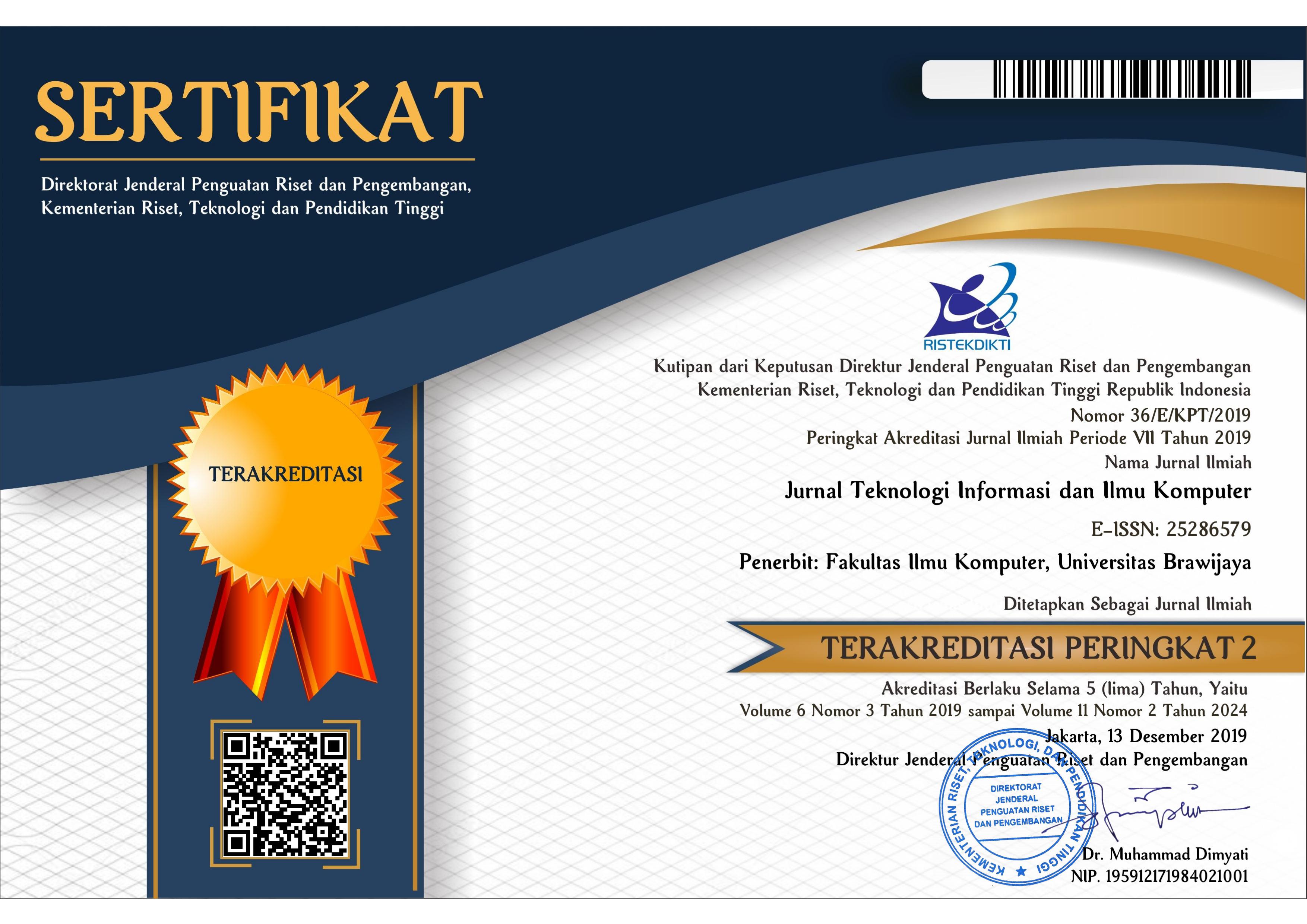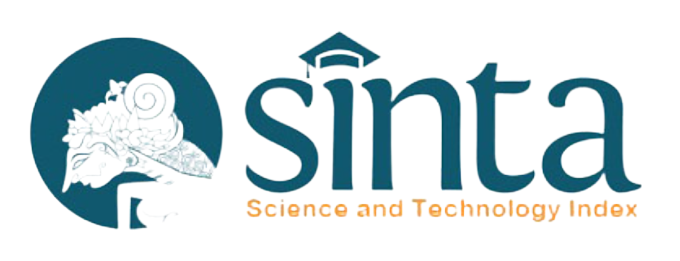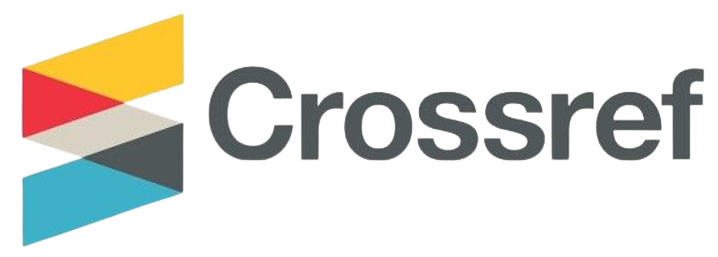Klasifikasi Citra Generasi Artificial Intellegence menggunakan Metodde Fine Tuning pada Residual Network
DOI:
https://doi.org/10.25126/jtiik.1138118Kata Kunci:
klasifikasi citra, generasi AI, fine tuning, residual networkAbstrak
Citra generasi AI memiliki beragam manfaat yang signifikan, baik dalam bidang penelitian maupun industri. Namun, penggunaan citra generasi AI juga memiliki dampak negatif dalam konteks hukum, politik dan berbagai aspek lain dalam kehidupan. Penelitian ini menitik beratkan klasifikasi citra generasi AI yang dapat mendeteksi keaslian dari suatu citra. Metode yang diusulkan adalah menggunakan model residual network yang telah dilakukan fine tuning. Teknik fine tuning yang dilakukan meliputi penggunaan learning rate scheduler berbasis warm up yang diikuti dengan linear scheduler, akumulasi gradien, dan augmentasi citra. Penelitian menunjukkan bahwa model residual network 152 menghasilkan performa terbaik dengan f1 score 0.963 dan loss 0.08.
Abstract
AI-generated images have various significant benefits, both in the realm of research and industry. However, the use of AI-generated images also has negative impacts in legal, political, and various other aspects of life. This research focuses on the classification of AI-generated images that can detect the authenticity of an image. The proposed method involves using a fine-tuned residual network model. The fine-tuning techniques applied include the use of a warm-up-based learning rate scheduler that followed by linear scheduler, gradient accumulation, and image augmentation. The research demonstrates that the Residual Network 152 model achieves the best performance with a f1 score of 0.963 and a loss of 0.08.
Downloads
Referensi
BIRD, J. J., & LOTFI, A. 2023. CIFAKE: Image Classification and Explainable Identification of AI-Generated Synthetic Images (arXiv:2303.14126). arXiv. https://doi.org/10.48550/arXiv.2303.14126.
CHEN, X., XU, C., YANG, X., SONG, L., & TAO, D. 2019. Gated-GAN: Adversarial Gated Networks for Multi-Collection Style Transfer. IEEE Transactions on Image Processing, 28(2), 546–560. https://doi.org/10.1109/TIP.2018.2869695.
CHEN, Z., CHEN, L., ZHAO, Z., & WANG, Y. 2020. AI Illustrator: Art Illustration Generation Based on Generative Adversarial Network. 2020 IEEE 5th International Conference on Image, Vision and Computing (ICIVC), 155–159. https://doi.org/10.1109/ICIVC50857.2020.9177494.
DHARIWAL, P., & NICHOL, A. 2021. Diffusion Models Beat GANs on Image Synthesis (arXiv:2105.05233). arXiv. https://doi.org/10.48550/arXiv.2105.05233.
GOODFELLOW, I. J., POUGET-ABADIE, J., MIRZA, M., XU, B., WARDE-FARLEY, D., OZAIR, S., COURVILLE, A., & BENGIO, Y. 2014. Generative Adversarial Networks (arXiv:1406.2661). arXiv. https://doi.org/10.48550/arXiv.1406.2661.
GOTMARE, A., KESKAR, N. S., XIONG, C., & SOCHER, R. 2018. A Closer Look at Deep Learning Heuristics: Learning rate restarts, Warmup and Distillation. https://doi.org/10.48550/ARXIV.1810.13243.
HE, K., ZHANG, X., REN, S., & SUN, J. 2015. Deep Residual Learning for Image Recognition (arXiv:1512.03385). arXiv. https://doi.org/10.48550/arXiv.1512.03385.
HO, J., JAIN, A., & ABBEEL, P. 2020. Denoising Diffusion Probabilistic Models (arXiv:2006.11239). arXiv. https://doi.org/10.48550/arXiv.2006.11239.
HUANG, G., LIU, Z., VAN DER MAATEN, L., & WEINBERGER, K. Q. 2017. Densely connected convolutional networks. In Proceedings of the IEEE conference on computer vision and pattern recognition (pp. 4700-4708). https://doi.org/10.1109/CVPR.2017.243.
KIM, J., KANG, H., YANG, J., JUNG, H., LEE, S., & LEE, J. 2023. Multitask Deep Learning for Human Activity, Speed, and Body Weight Estimation Using Commercial Smart Insoles. IEEE Internet of Things Journal, 10(18), 16121–16133. https://doi.org/10.1109/JIOT.2023.3267335.
LEDIG, C., THEIS, L., HUSZAR, F., CABALLERO, J., CUNNINGHAM, A., ACOSTA, A., AITKEN, A., TEJANI, A., TOTZ, J., WANG, Z., & SHI, W. 2017. Photo-Realistic Single Image Super-Resolution Using a Generative Adversarial Network (arXiv:1609.04802; Versi 5). arXiv. https://doi.org/10.48550/arXiv.1609.04802.
LI, X., XIA, Y., LONG, X., LI, Z., & LI, S. 2021. Exploring Text-Transformers in AAAI 2021 Shared Task: COVID-19 Fake News Detection in English. Dalam T. Chakraborty, K. Shu, H. R. Bernard, H. Liu, & M. S. Akhtar (Ed.), Combating Online Hostile Posts in Regional Languages during Emergency Situation (Vol. 1402, hlm. 106–115). Springer International Publishing. https://doi.org/10.1007/978-3-030-73696-5_11.
MARAS, M.-H., & ALEXANDROU, A. 2019. Determining authenticity of video evidence in the age of artificial intelligence and in the wake of Deepfake videos. The International Journal of Evidence & Proof, 23(3), 255–262. https://doi.org/10.1177/1365712718807226.
MORANDÍN-AHUERMA, F. 2022. What is Artificial Intelligence. 3(12). International Journal of Research Publication and Reviews. DOI: 10.55248/gengpi.2022.31261.
SIMONYAN, K., & ZISSERMAN, A. 2014. Very deep convolutional networks for large-scale image recognition. arXiv preprint. https://doi.org/10.48550/arXiv.1409.1556.
SZEGEDY, C., LIU, W., JIA, Y., SERMANET, P., REED, S., ANGUELOV, D., & RABINOVICH, A. 2015. Going deeper with convolutions. In Proceedings of the IEEE conference on computer vision and pattern recognition (pp. 1-9). doi: 10.1109/CVPR.2015.7298594.
PEREZ, L., & WANG, J. 2017. The Effectiveness of Data Augmentation in Image Classification using Deep Learning (arXiv:1712.04621). arXiv. https://doi.org/10.48550/arXiv.1712.04621.
TANG, S., & DE SA, V. R. 2020. Deep Transfer Learning with Ridge Regression (arXiv:2006.06791). arXiv. https://doi.org/10.48550/arXiv.2006.06791.
WESTERLUND, M. 2019. The Emergence of Deepfake Technology: A Review. Technology Innovation Management Review, 9(11), 39–52. https://doi.org/10.22215/timreview/1282.
WIGHTMAN, R., TOUVRON, H., & JÉGOU, H. 2021. ResNet strikes back: An improved training procedure in timm. https://doi.org/10.48550/ARXIV.2110.00476.
WU, X., XU, K., & HALL, P. 2017. A survey of image synthesis and editing with generative adversarial networks. Tsinghua Science and Technology, 22(6), 660–674. https://doi.org/10.23919/TST.2017.8195348.
XIONG, R., YANG, Y., HE, D., ZHENG, K., ZHENG, S., XING, C., ZHANG, H., LAN, Y., WANG, L., & LIU, T.-Y. 2020. On Layer Normalization in the Transformer Architecture. https://doi.org/10.48550/ARXIV.2002.04745.
YAN, M., YANG, J., CHEN, C., ZHOU, J. T., PAN, Y., & ZENG, Z. 2022. Enhanced gradient learning for deep neural networks. IET Image Processing, 16(2), 365–377. https://doi.org/10.1049/ipr2.12353.
ZANNETTOU, S., SIRIVIANOS, M., BLACKBURN, J., & KOURTELLIS, N. 2019. The Web of False Information: Rumors, Fake News, Hoaxes, Clickbait, and Various Other Shenanigans. Journal of Data and Information Quality, 11(3), 1–37. https://doi.org/10.1145/3309699.
ZHUANG, Z., LIU, M., CUTKOSKY, A., & ORABONA, F. 2022. Understanding AdamW through Proximal Methods and Scale-Freeness. https://doi.org/10.48550/ARXIV.2202.00089.
Unduhan
Diterbitkan
Terbitan
Bagian
Lisensi
Hak Cipta (c) 2024 Jurnal Teknologi Informasi dan Ilmu Komputer

Artikel ini berlisensiCreative Commons Attribution-ShareAlike 4.0 International License.

Artikel ini berlisensi Creative Common Attribution-ShareAlike 4.0 International (CC BY-SA 4.0)
Penulis yang menerbitkan di jurnal ini menyetujui ketentuan berikut:
- Penulis menyimpan hak cipta dan memberikan jurnal hak penerbitan pertama naskah secara simultan dengan lisensi di bawah Creative Common Attribution-ShareAlike 4.0 International (CC BY-SA 4.0) yang mengizinkan orang lain untuk berbagi pekerjaan dengan sebuah pernyataan kepenulisan pekerjaan dan penerbitan awal di jurnal ini.
- Penulis bisa memasukkan ke dalam penyusunan kontraktual tambahan terpisah untuk distribusi non ekslusif versi kaya terbitan jurnal (contoh: mempostingnya ke repositori institusional atau menerbitkannya dalam sebuah buku), dengan pengakuan penerbitan awalnya di jurnal ini.
- Penulis diizinkan dan didorong untuk mem-posting karya mereka online (contoh: di repositori institusional atau di website mereka) sebelum dan selama proses penyerahan, karena dapat mengarahkan ke pertukaran produktif, seperti halnya sitiran yang lebih awal dan lebih hebat dari karya yang diterbitkan. (Lihat Efek Akses Terbuka).














